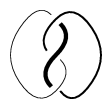Fox-n-colouring
A colouring of a non-oriented link diagram (cf. also Knot and link diagrams), leading to an Abelian group invariant of links in  (cf. also Link). It was introduced by R.H. Fox around 1956 to visualize dihedral representations of the knot group [a1] (cf. also Knot and link groups). Using
(cf. also Link). It was introduced by R.H. Fox around 1956 to visualize dihedral representations of the knot group [a1] (cf. also Knot and link groups). Using  -colourings is, probably, the simplest method of showing that the trefoil knot is non-trivial (see Fig.a1).
-colourings is, probably, the simplest method of showing that the trefoil knot is non-trivial (see Fig.a1).
One says that a link (or tangle) diagram,  , is
, is  -coloured if every arc is coloured by one of the numbers
-coloured if every arc is coloured by one of the numbers  in such a way that at each crossing the sum of the colours of the undercrossings is equal to twice the colour of the overcrossing modulo
in such a way that at each crossing the sum of the colours of the undercrossings is equal to twice the colour of the overcrossing modulo  . The set of
. The set of  -colourings forms an Abelian group, denoted by
-colourings forms an Abelian group, denoted by  . This group can be interpreted using the first homology group (modulo
. This group can be interpreted using the first homology group (modulo  ) of the double branched cover of
) of the double branched cover of  with the link as the branched point set. The group of
with the link as the branched point set. The group of  -colourings is determined by the Jones polynomial (at
-colourings is determined by the Jones polynomial (at  ), and the group of
), and the group of  -colourings by the Kauffman polynomial (at
-colourings by the Kauffman polynomial (at  ,
,  ), [a2].
), [a2].  -moves preserve the group of
-moves preserve the group of  -colourings and
-colourings and  -moves lead to the Montesinos–Nakanishi conjecture.
-moves lead to the Montesinos–Nakanishi conjecture.

Figure: f130220a
The linear space of  -colourings of the boundary points of an
-colourings of the boundary points of an  -tangle has a symplectic form (cf. also Symplectic structure), so that tangles correspond to Lagrangian subspaces (i.e. maximal totally degenerate subspaces) of the symplectic form.
-tangle has a symplectic form (cf. also Symplectic structure), so that tangles correspond to Lagrangian subspaces (i.e. maximal totally degenerate subspaces) of the symplectic form.
The Alexander module is a generalization of the group of  -colourings.
-colourings.
References
| [a1] | R.H. Crowell, R.H. Fox, "An introduction to knot theory" , Ginn (1963) |
| [a2] | J. Przytycki, "3-coloring and other elementary invariants of knots" , Knot Theory , Banach Center Publications , 42 (1998) pp. 275–295 |
Fox-n-colouring. Encyclopedia of Mathematics. URL: http://encyclopediaofmath.org/index.php?title=Fox-n-colouring&oldid=40104